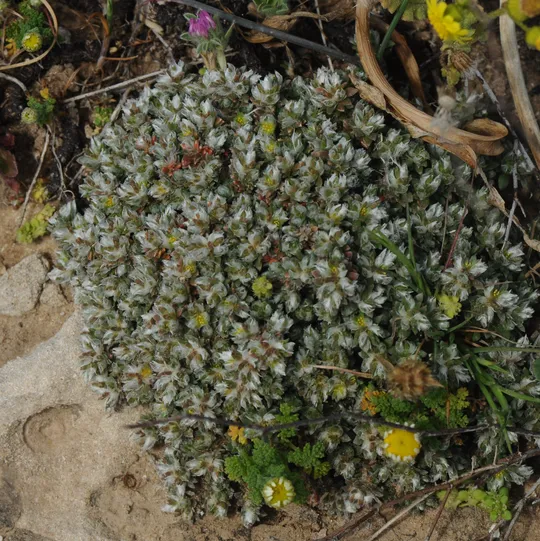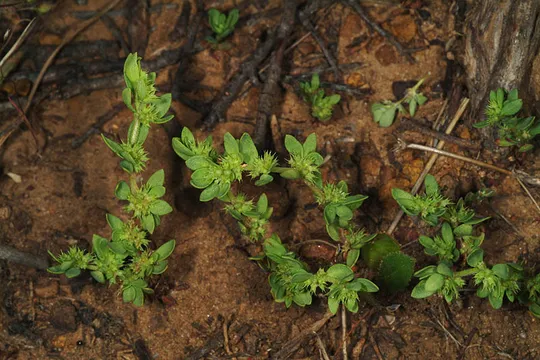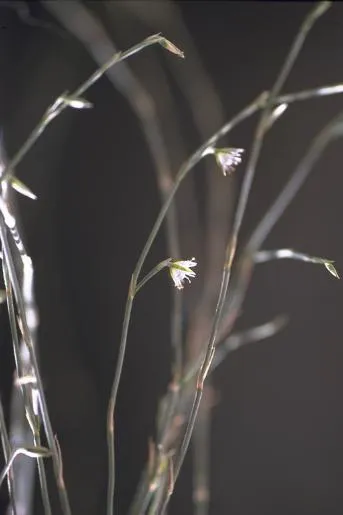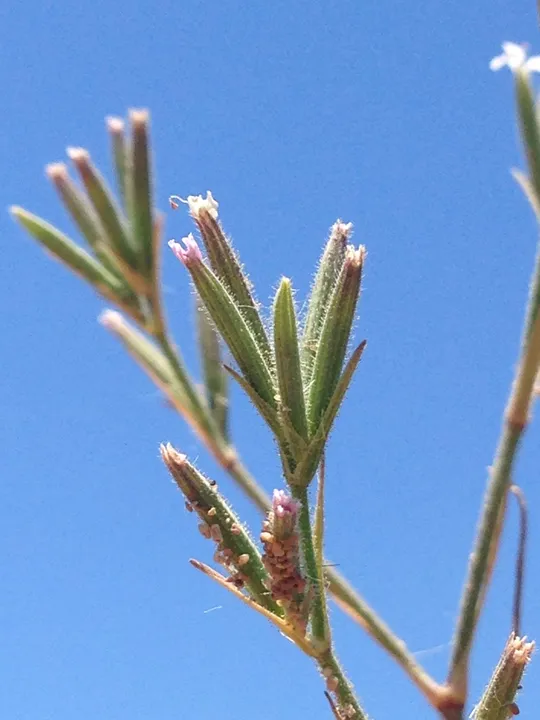Common Corn Cockle, Bastard Nigella
Agrostemma githago
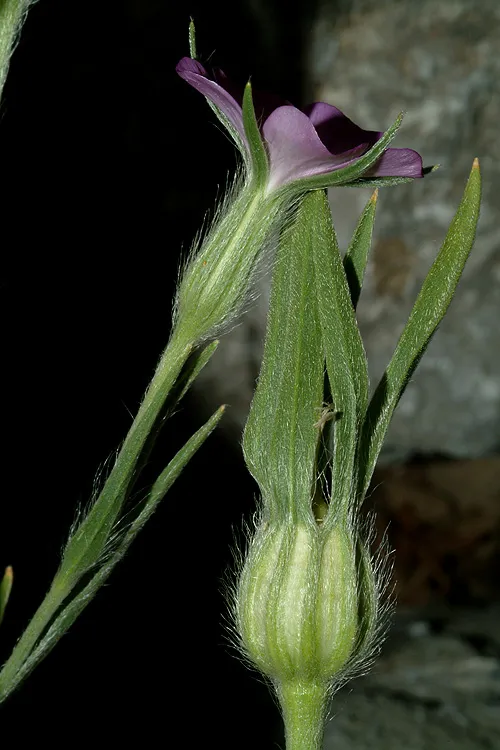
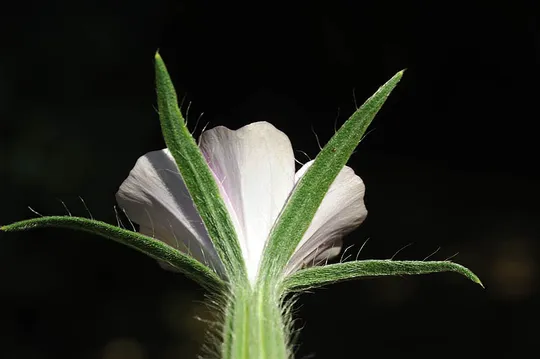
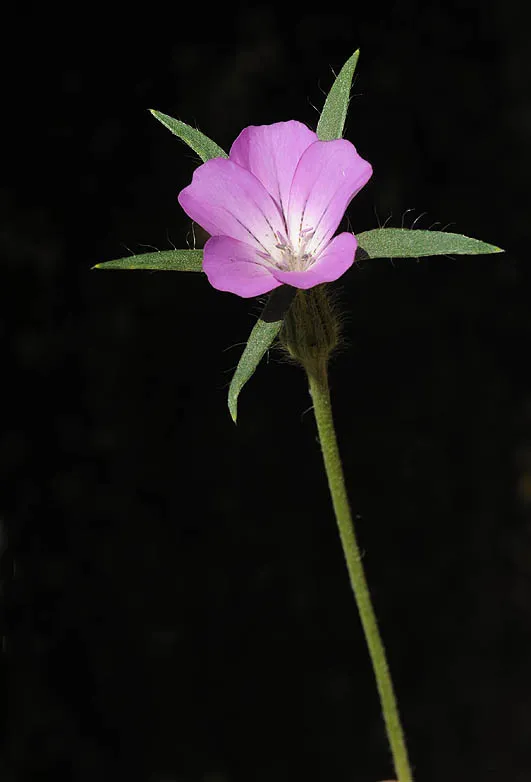
Agrostemma githago is a hairy, erect annual weed, 40-70
cm tall, with beautiful purple flowers. Its
leaves and stems are covered in long silky
white hairs. Leaves are opposite and very elongated. The calyx tube is very long (1-2 cm) and has
10 prominent ribs. The calyx tubes ends in five pointed teeth, that
are slightly longer than the tube. Petals are equal to the calyx teeth or
slightly shorter than them. The fruit is a large, plump capsule, with
five valves. Agrostemma is known to grow in agricultural fields. Its
seeds are similar in size and weight to other cereal seeds – wheat, barley and rye
– and they spread with them and are difficult to separate from them. In
this manner, humans propagated the species as a weed in most temperate
regions of the world. The seeds are toxic and
cause diarrhea.
In the past Agrostemma grew in seven different regions: Philistean Plain (Mikve Israel, Borochov neighborhood), Sharon (Pardes Hanna, Ilanot), Carmel Coast (Ma’agan Mikhael), Jerusalem Mountains, Kinarot Valley (Kineret), Upper Galilee and Golan Heights. Following the establishment of the state of Israel it was no longer found on the Coastal Plain, and probably became extinct probably due to the decrease in heavy soil areas near flowing streams. Improved sorting of cereal seeds reduced the potential for Agrostemma propagation by sowing cereals. Surprisingly, in 1992 a few plants were growing at the edge of the Taninim Stream, but since then they have not been observed again. Similarly they were found in Mount Meron area near the forester's station in 1993, but have not been observed there again. The only known stable population in the country is in the one on Mount Avital and Mount Bental; interestingly this population grows on scoria, not a characteristic Agrostemma habitat. Oz Golan believes that he collected the species in Moshav Yakhini near Sderot in 2005.
Most of the plants in Israel were collected on heavy soils adjacent to water bodies and irrigated fields. Apparently its main habitat in the Levant is heavy soil valley soils that are seasonally that are flooded in winter and cultivated in the summer. The plant is known in Europe as weed in agricultural fields. In the northern Golan Heights Agrostemma grows on arid basalt slopes –a completely different habitat from the usual areas it grows in.
The genus Agrostemma can be told apart from the genus Dianthus by its calyx that has no bracts and from the genus Silene by its very long calyx teeth. Another species, Agrostemma gracile is described in the Israeli literature, from Edom and the Philistean Plain from the early 1920s. The record from the Philistean Plain is based on Shauli Beckerstein who found it in Jaffa, but apparently it was confused with Agrostemma githago and the species probably does not grow in Israel nor did it grow here in the past. Therefore it was not included in the Red Book. Nevertheless in 2007 Shauli Beckerman found a specimen of Agrostemma on Tel Avital, with petals much shorter than its calyx, which is one of the features of A. gracile; A. githago grows on the same site, thus the site and the taxonomy of the two species Israel should be studied further.
• The loss of suitable habitats habitats is probably the main reason for the declining number of sites. In the first half of the 20th century the species was recorded in Israel at eight sites.
• The distribution pattern was very fragmented. As more populations disappeared the distance and isolation between populations has increased even more.
• On all sites except for Mount Avital, the species was randomly collected and there were no reports on the population size over the years. Since the 1980s evidence of Agrostemma has been anecdotal (places such as Mount Meron, Ma’agan Mikhael) and no further sightings were made in the years following the “discovery”. Mount Avital is the only site where plants can be found every year. The population there numbers 5-40 individuals.
• In European countries it used to be a common plant in fields, but due improved methods of seed sorting it is now endangered in some countries. The plant invaded the United States where it is not endangered. Although the plant is now widespread in Europe, Thompson (1973) assumes that the primary habitat was in the Middle East. Therefore its presence on Mount Avital in its primary habitat is very significant, and it is important to preserve this habitat.
The species should be restored to heavy soil areas near river banks on the Coastal Plain in the Ayalon Stream, WadiPoleg, Taninim Stream and Alexander Stream.
Agrostemma githago is aplant whose origins are northern Mediterranean, but it is quite common in southern Europe; Israel it is at the southern edge of its distribution. Its range includes all of Europe (with the exception of its north), southern Russia and penetrates into the western part of the Irano–Turanian region. The plant reached the Americas and is considered an invasive species in agricultural fields.
An annual plant, very rare, that has almost completely vanished from Israel. The plant has disappeared from most parts of the country where it grew in past, due to the decrease in the number of suitable sites. Today Agrostemma can only be found in the northern Golan Heights on Mount Avital. The species was accidentally found on two occasions (on Mount Meron, in Taninim Stream). Should be prioritized for conservation.
שמידע, א. וליסטון, א. 1984. צמחים נדירים בארץ – אגרוסטמת השדות – גילוי מחדש. רתם 12:
65-68.
Thompson,P.A., 1973, Effects of Cultivation on the germination character of the Corn Cockle (Agrostemma githago). Ann.Bot. 37,133-154.
Current Occupancy Map
| 1000 squre meter pixel | 5000 squre meter pixel | 10000 squre meter pixel | |
|---|---|---|---|
| number of observations | 0 | 0 | 0 |
| in total pixels | 0 | 0 | 0 |
| Family | Caryophyllaceae |
| Classification | On the endangered species list |
| Ecosystem | Mediterranean |
| Chorotype | Mediterranean with Euro-Siberian and Irano-Turanian incursions |
| Conservation Site | Taninim Stream on heavy soil, Mount Avital |
| Rarity |
1
4
6
|
|---|---|
| Vulnerability |
0
2
4
|
| Attractiveness |
0
2
4
|
| Endemism |
0
0
4
|
| Red number |
1
4.7
10
|
| Peripherality | N |
| IUCN category | DD EW EX LC CR EN VU NT |
| Threat Definition according to the red book | Endangered |
 Based on:
Based on:
